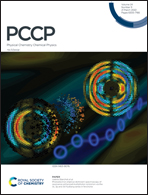The exchange between anions and cations induced by coupled plasma and thermal annealing treatment for room-temperature ferromagnetism†
Abstract
Two-dimensional (2D) materials, with outstanding magnetic properties at room temperature, are highly desirable for the future spintronic and nanoscale electronic industry. However, most of the 2D systems are not of magnetic nature due to thermal fluctuations. Herein, we propose a novel strategy to induce robust room-temperature ferromagnetism in the originally nonmagnetic 2D ReS2 by the exchange between anions and cations. The vacancies are created by argon plasma treatment, which lowers the formation energy of point defects. The subsequent annealing facilitates the movement of the cations into the anion sites, giving rise to antisite defects, which leads to a significant increase in the magnetization. First-principles calculations demonstrate that the point defect with respect to the antisite substitution from Re to S is responsible for the extraordinary room-temperature ferromagnetism. This work opens a new door to the design of spin electronic structures by controllable antisite defects.



 Please wait while we load your content...
Please wait while we load your content...